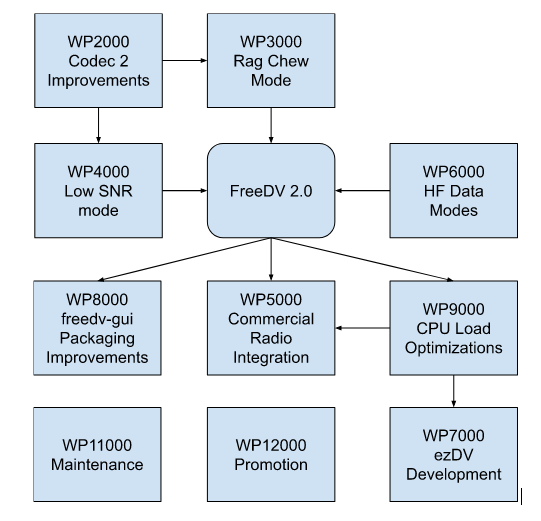In early 2023, we were fortunate to receive a grant from the ARDC, to support a two year program of FreeDV development. This post in an excerpt from our grant application that describes the project plan we are now busy executing.

I have a background in project planning, so with the FreeDV Project Leadership team (PLT) designed the plan in work package form, much as I would plan a commercial project.
The work package breakdown is provided below, however we expect this will evolve over the course of the project. The grant funding will be directed by the FreeDV PLT to best accomplish our mission of creating great free software and hardware for digital voice communication over HF radio.
WP1000 Project Management. Budget at 10% of project. Coordinate resources, hiring a DSP engineer, and communication with stakeholders. Evaluate progress against the plan, revise plan as project evolves.
WP2000 Codec 2 Improvement. In this WP we will attempt to improve the speech quality of two Codec 2 modes, at a low (around 700 bit/s) and moderate (1200-2400) bit/s rate. Establish requirements for Codec 2 (bit rate, voice quality, background noise robustness, CPU load). The most promising areas are spectral quantisation and a better excitation model. Develop algorithms for handling background noise. The moderate bit rate modes in Codec 2 (above 700 bits/s) have not been actively developed for many years, so there is likely some low hanging fruit here. Progress in this WP will be measured by conducting tests using speech samples processed with the revised modes and SSB/commercial codecs as references.
WP3000 Rag chew mode. A waveform for HF digital voice will be designed to use the new 1200-2400 bits/s mode from WP2000. Waveform design involves designing the modem, FEC code selection, and implementation. The new waveform will be supported by automated tests, and integrated into libcodec2 and freedv-gui for use over the air. A option for a high quality mode is to employ the neural speech coding (as per the experimental FreeDV 2020 modes).
WP4000 Low SNR mode. Using our existing 700D/700E modes, carefully investigate modem performance over HF multipath channels (real and simulated), measure performance compared to theory, and look for potential optimisations. Investigate the use of non-pilot symbol synchronization methods to lower waveform overheads. Investigate methods for Peak to Average Power Ratio (PAPR) reduction by Vector Quantiser (VQ) and interleaver optimisation. With the new 700 bit/s codec from WP2000, develop a new low SNR waveform, integrate into libcodec2 and freedv-gui for use over the air. Success will be measured by conducting controlled over the air experiments where we compare SSB to the low SNR mode using the same speech samples and Peak power. The goal is to outperform SSB at low SNRs.
WP5000 Commercial radio integration. When WP3000 and WP4000 are mature, reach out to commercial radio companies. Promote the benefits of FreeDV: open standards, no license fees, and performance competitive to SSB. Options for integration include linking libcodec2 into their radios DSP/Host CPU, or a plug-in OEM FreeDV module using a STM32 or ESP32 microcontroller. Success will be measured against the goal of integrating FreeDV into at least 2 COTS HF radios serving the Amateur Radio market.
WP6000 HF Data Modes: Extend the current suite of HF data waveforms by developing and testing a high bit rate/high SNR QAM mode and sub 0dB SNR low SNR mode. Work with FreeDATA to integrate and test Over the Air (OTA). Conduct an automated test campaign over many months that provides objective evidence of system performance over real world channels.
WP7000 ezDV Development: Extend ezDV with additional functionality and for ease of use. Develop a usable enclosure for the ezDV board and optimize the hardware for production, as well as manufacture a small run of devices for general ham use and testing.
WP8000 Packaging Improvements: Improves the codebase and workflow to enable easier packaging of official releases by the major Linux distributions. Code signing (for platforms that heavily encourage/require it) will be put in place.
WP9000 CPU load optimizations: These are items intended to reduce the CPU required to run FreeDV. This activity is scheduled to start after the new modes have been developed.
WP10000: freedv-gui improvements: These are items intended to improve the general usability of the FreeDV application.
WP11000 Ongoing development and maintenance: libcodec2, freedv-gui, and embedded platforms (ezDV, the SM1000 successor). In addition to ongoing maintenance such as documentation of Codec 2 algorithm and FreeDV waveforms to a professional level. This will encourage commercial adoption.
WP12000 Ongoing promotion: Provide a presence at major hamventions in the form of a FreeDV/Codec2 booth and/or talks given by the group. This presence would have live demos of FreeDV (both using the application and with embedded devices such as ezDV). There would be up to five hamventions targeted in this grant, with the ones selected based on historical attendance figures.
The project will also participate in various forms of other promotion (for example, on-air events, mailing lists, social media and discussion forums). Usage figures can be measured from online reporting during events (e.g. reports that are sent from the FreeDV PC application to the PSK Reporter service).